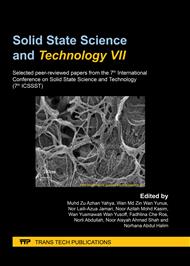[1]
O.O. Olusola, O.I. Olusola, K.A. Aduloju, G.E. Adesakin, E.A. Odo, Investigating the optical and electrical properties of ZnSe thin films prepared by chemical bath deposition technique, IOSR J. Appl. Phys. 9(6) (2017) 6-12.
Google Scholar
[2]
Y. Hamid, M. Rashid, S.B.O. Abdul Hamid, B.H. Ong, The effects of deposition time and seed layer on morphological properties of zinc oxide by chemical bath deposition, Sol. St. Phen. 264 (2017) 240-243.
DOI: 10.4028/www.scientific.net/ssp.264.240
Google Scholar
[3]
S. Li, L. Wang, X. Su, Y. Pan, D. Gao, X. Han, Optical properties of Co-doped ZnSe thin films synthesized by pulsed laser deposition, Thin Solid Films (2019) 137599.
DOI: 10.1016/j.tsf.2019.137599
Google Scholar
[4]
Q. Bao, C. Chen, D. Wang, Q. Ji, T. Lei, Pulsed laser deposition and its current research status in preparing hydroxyapatite thin films, Appl. Surf. Sci. 252(5) (2005) 1538-1544.
DOI: 10.1016/j.apsusc.2005.02.127
Google Scholar
[5]
H.H. Yudar, S. Pat, S. Korkmaz, S. Özen, V. Şenay, Zn/ZnSe thin films deposition by RF magnetron sputtering, J. Mater. Sci-Mater. El. 28(3) (2017) 2833-2837.
DOI: 10.1007/s10854-016-5866-6
Google Scholar
[6]
I.M. Dharmadasa, J. Haigh. Strengths and advantages of electrodeposition as a semiconductor growth technique for applications in macroelectronic devices, J. Electrochem. Soc. 153(1) (2006) G47-G52.
DOI: 10.1149/1.2128120
Google Scholar
[7]
R. Kowalik, P. Żabiński, K. Fitzner, Electrodeposition of ZnSe, Electrochim. Acta. 53(21) (2008) 6184-6190.
DOI: 10.1016/j.electacta.2007.12.009
Google Scholar
[8]
F.A. Kröger, Cathodic deposition and characterization of metallic or semiconducting binary alloys or compounds, J. Electrochem. Soc. 125(12) (1978) 2028-2034.
DOI: 10.1149/1.2131357
Google Scholar
[9]
L. Mohd Fudzi, Z. Zainal, H. Lim, S.K. Chang, A. Holi, Effect of temperature and growth time on vertically aligned ZnO nanorods by simplified hydrothermal technique for photoelectrochemical cells, Materials 11(5) (2018) 704.
DOI: 10.3390/ma11050704
Google Scholar
[10]
J. Tauc, R. Grigorovici, A. Vancu, Optical properties and electronic structure of amorphous germanium, Phys. Status. Solidi. (b) 15(2) (1966) 627-637.
DOI: 10.1002/pssb.19660150224
Google Scholar
[11]
B.D. Viezbicke, S. Patel, B.E. Davis, D.P. Birnie III, Evaluation of the Tauc method for optical absorption edge determination: ZnO thin films as a model system, Phys. Status. Solidi. (b) 252(8) (2015) 1700-1710.
DOI: 10.1002/pssb.201552007
Google Scholar
[12]
G.M. Lohar, S.T. Jadhav, M.V. Takale, R.A. Patil, Y.R. Ma, M.C. Rath, V.J. Fulari. Photoelectrochemical cell studies of Fe2+ doped ZnSe nanorods using the potentiostatic mode of electrodeposition, J. Colloid. Interf. Sci. 458 (2015) 136-146.
DOI: 10.1016/j.jcis.2015.07.046
Google Scholar
[13]
A.M. Holi, Z. Zainal, Z.A. Talib, H.N. Lim, C.C. Yap, S.K. Chang, A.K. Ayal, Hydrothermal deposition of CdS on vertically aligned ZnO nanorods for photoelectrochemical solar cell application, J. Mater. Sci.: Mater. Electron. 27(7) (2016) 7353-7360.
DOI: 10.1007/s10854-016-4707-y
Google Scholar
[14]
P. Chen, L. Gu, X. Cao, From single ZnO multipods to heterostructured ZnO/ZnS, ZnO/ZnSe, ZnO/Bi2S3 and ZnO/Cu2S multipods: controlled synthesis and tunable optical and photoelectrochemical properties, Cryst. Eng. Comm. 12(11) (2010) 3950-3958.
DOI: 10.1039/c001615b
Google Scholar
[15]
G. Riveros, H. Gomez, R. Henrıquez, R. Schrebler, R.E. Marotti, E.A. Dalchiele, Electrodeposition and characterization of ZnSe semiconductor thin films, Sol. Energ. Mat. Sol. C. 70(3) (2001) 255-268.
DOI: 10.1016/s0927-0248(01)00066-6
Google Scholar


